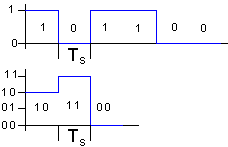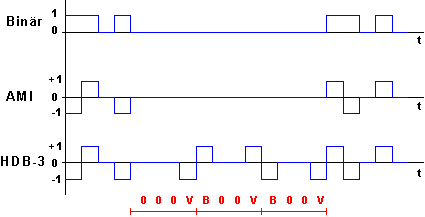Cable code
Digital signals can have relatively high aperiodic component. E.G.
by the frequent lining up of 1 or 0. These signals are subject to an
absorption on a longer transmission circuit.
Digital signals are changed by a cable code in such a way that they are suitable for the transmission on long lines.
The following demands are made against the cable codes:
- The signal which can be transmitted must be DC voltage-free.
- The process of the amplitude spectrum must lie in the transmission window of the line.
- The information signal should contain flank changes for clock recuperation as much as possible.
- The monitoring of the signal sequence must take place via coding rules.
In the communicationses usual cable codes:

| Binary |
|---|
| AMI code |
|---|
The AMI(Alternate Mark Inversion) code uses a positive and a
negative Spannung(AMI Regel) for the transmission of the logic 1
alternating. In this way the DC voltage liberty is manufactured. The
AMI code does not prevent jecoch long 0-Folgen.
It is called
pseudoternary code, because for the transmission of 2 logical
conditions, altogether 3 tensile states for order to stand.
Step duration T S = 125 µs
Modulation rate v S = 8 kBaud
 | Binary |
|---|
| AMI code |
|---|
 | Modified AMI code |
|---|
The modified AMI code differs from the AMI code only by the fact
that alternating a positive and a negative tension lead the logic 0.
The modified AMI code is used as cable code on the S0-Bus.
The 4B3T-Code combines in each case 4 Bit(4B) of a binary signal
into a block, and codes it in three ternary Signalelemente(3T). The
allocation of the 4B-Werte in 3T-Elemente takes place after a code
table.
As a 4B-Wort is coded in each case, depends on the coding of
the previous 4B-Wortes. In this way the direct current liberty is
realized.
By the code conversion from 4 bits to 3 bit, amounts to the modulation rate only 75% in relation to transmission rate.
For the clock recuperation a Scrambler is necessary.
Step duration T S = 1666.67 µs
Modulation rate v S = 6 kBaud
Transmission rate v D = 8 kBit
The 4B3T-Code was used in the national and in the euro ISDN(U K0 interface) of the German Telekom as cable code.
 |
Binary |
|---|
| Quaternaer |
|---|
With the 2B1Q-Code 2 binary signals are converted into a
Quaternaeres signal. This knows 4 different conditions haben(00, 01,
10, 11).
The modulation rate v S amounts to only 50% of transmission rate v D .
Duch
the use of the 2B1Q-Leitungscodes is reduced the frequency spectrum
necessary for the transmission. By the use of the lower part of the
frequency spectrum the absorption precipitates extremely small. Also
the disturbance of neighbouring veins by the transmission is low.
The 2B1Q-Code is used in the euro ISDN(U K0 interface) as cable code.
The HDB3-Code(High Density bipolar = high close of bipolar
indications) is a bipolar cable code with high insensitivity to
interference.
The HDB-3-Code is a modified form of the AMI code.
The original AMI code is however not changed. The additive "3" states
that with this cable code any more than 3 zeros in consequence do not
arise.

At a group of bits with 4 zeros in consequence the fourth bit
is replaced by a Verletzungsbit(V). This injury bit always accepts the
same polarity, as the last preceding 1-Bit. If a further group of bits
with 4 zeros follows, the first zero are replaced by additional bit
(B). This bit has the reverse polarity to the preceding injury bit.
Advantages by this cable code:
- secure clock recuperation without Scrambler, by frequent polarity changes
- direct currentless potential gradient
Application finds the HDB-3-Code on PCM30-Uebertragungsstrecken.
Further related topics:
 |
 |


Sharp GX30
Das erste Handy mit Megapixel-Kamera in Europa
bei Vodafone
199,- EUR*
|
|
|
 Price trend
is the specialist under the price comparison portals in Germany offers
with its up to date price comparison an ideal Shopping platform
approximately around computers hard and software as well as
entertainment electronics and telecommunications. Price trend
is the specialist under the price comparison portals in Germany offers
with its up to date price comparison an ideal Shopping platform
approximately around computers hard and software as well as
entertainment electronics and telecommunications. |
| 
